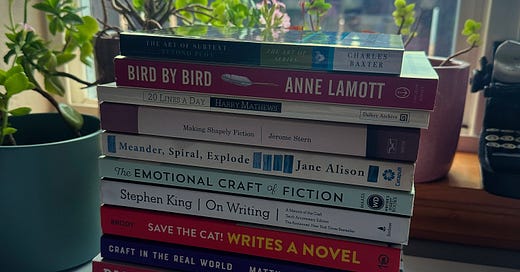So, You Want to Write a Novel but Don’t Know Where to Begin
10 Books That Will Make You a Better Writer
If you’re staring at a blank page, unsure where to start your novel-writing journey, you’re not alone. Writing a novel is an exciting but daunting process, and finding the right approach can make all the difference.
For me, I chose the Snowflake Method—a technique that begins with a single idea and gradually expands into a full manuscript, much like the intricate formation of a snowflake. You start with a one-sentence summary, then build it into a paragraph, develop character profiles, and flesh out your story from there. This website is a great resource for understanding the method in depth.
Once I had a solid foundation, I knew I needed an outline, which led me to Save the Cat! Writes a Novel by Jessica Brody. This book provides a tried-and-true story structure, especially useful for first-time novelists. I highly recommend it for anyone struggling to shape their story.
From there, I fell down the rabbit hole of books about writing, each offering invaluable insights into craft, structure, and storytelling. Here are some of my top recommendations:
1. Writing Fiction – Janet Burroway
This book is my BIBLE for fiction writing. As a beginner, I had no idea how to develop characters, craft a compelling plot, or structure a story. This book covers it all. Read it. Seriously.
“There are six basic methods of character presentation. The four direct methods - dialogue, appearance, action, and thought - show us the characters as they speak, look, move, and feel.”
2. Bird by Bird – Anne Lamott
Ah, shitty first drafts. Lamott reassures us that all writers struggle in the beginning, and that’s okay. Writing is hard, and this book will make you feel less alone when you hit that inevitable wall of self-doubt.
“In the beginning, when you’re first starting out there are a million reasons not to write, to give up. That is why it is of extreme importance to make a commitment to finishing sections and stories, to driving through to the finish.”
3. The Art of Subtext – Charles Baxter
We’ve all heard show, don’t tell, but what does that really mean? Baxter explores how subtext enriches storytelling, urging writers to create moments that let readers infer meaning.
“A novel is not a summary of its plot, but a collection of instances, of luminous specific details that take us in the direction of the unsaid and unseen.”
4. Making Shapely Fiction – Jerome Stern
A practical guide packed with useful advice. My favorite part? The “Alphabet” section, which breaks down essential storytelling elements like accuracy, dialogue, scene, tension, and voice in an easily digestible way.
“Stories that begin by merely establishing that something is wrong - for example, that your character is depressed - still don’t really signal whether anything will happen.”
5. Craft in the Real World – Matthew Salesses
This book transformed how I think about believability in fiction. As writers, we define what makes a character believable or relatable—it’s not a fixed concept. Salesses challenges traditional storytelling norms and invites diverse narrative structures into literary spaces.
“We need to think about how to make more conscious decisions about audience and what that can do for our fiction. We need to think, in other words, about purpose. (Put theme and audience together, and purpose is what you get.)”
6. Meander, Spiral, Explode – Jane Alison
If you want to break away from traditional storytelling arcs, this book is for you. Alison examines how stories can take shape beyond the classic rise-and-fall structure, exploring narrative patterns like spirals, waves, and fractals.
“Memoirists know that they must look back over life to find patterns that give order. But this is true for anyone writing any kind of narrative.”
7. Intuitive Editing – Tiffany Yates Martin
I thought writing a first draft was hard until I got to revisions. This book walks through both macro and micro edits, covering character, show-don’t-tell, plot, and line editing.
“Storytelling is like a Jenga puzzle, where every piece affects the overall structure.”
8. The Emotional Craft of Fiction – Donald Maass
Great fiction isn’t just about plot—it’s about making readers feel. Maass dives into the emotional journey of both the reader and the writer, showing how to create deep, meaningful connections between protagonist and audience.
“If you want to write strong fiction, you must make your readers feel.”
9. Damn Fine Story – Chuck Wendig
A sharp, witty take on storytelling fundamentals. Wendig explores how characters shape plot and vice versa, introducing concepts like Freytag’s Pyramid and thematic development in a highly engaging way.
“If story is architecture, then characters are the architects.”
10. On Writing – Stephen King
Part memoir, part writing masterclass, this book offers a peek into King’s mind and process. It’s a must-read for any aspiring writer.
“Good writing consists of mastering the fundamentals (vocabulary, grammar, the elements of style) and then filling the third level of your toolbox with the right instruments.”
Final Thoughts
Writing a novel is a journey filled with excitement, frustration, and discovery. Whether you're just starting out or deep into revisions, these books will help you navigate the process with more confidence and clarity.
Now, back to writing!






If you're a writer (or dream of being one), you need this list! These books have shaped my journey, but Bird by Bird by Anne Lamott holds a special place in my heart.
This post is full of so many helpful things! Thank you. I loved On Writing by Stephen King. Now I can't wait to work my way through the rest of this list.